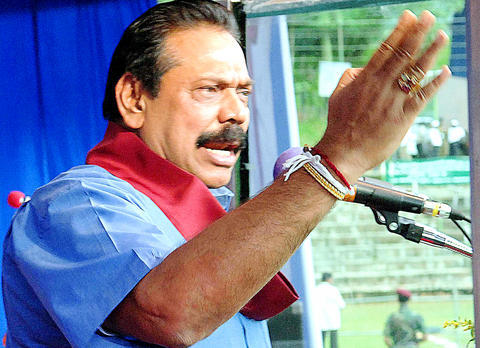Sri Lanka's president has ruled out a snap parliamentary election to increase his slender majority, after battlefield success against the Tamil Tiger rebels boosted his government.
President Mahinda Rajapakse said he was keen that the current parliament serve its full six-year term. It was elected in April 2004, while the president came to power in November 2005.
"I am not interested in calling a snap election," the president said late Saturday on the sidelines of his first public rally, in Nawalapitiya, central Sri Lanka, after troops captured the rebels' final bastion in the east.

PHOTO: AFP
"This is a very favorable time for our party, but I don't want to go for another general election and spend 2 billion rupees [US$18 million] to conduct that election.
"I can build a few more roads with that money. We have a stable government and I want other parties too to unite and move forward."
Blue flags for his party and banners welcoming him as a hero were raised across Nawalapitiya.
Maithripala Sirisena, the secretary of Rajapakse's Sri Lanka Freedom Party (SLFP), said Saturday's public rally represented the first in a series due across the country.
"We want to use these engagements to respond to some of the key issues as well as respond to criticism by the opposition," he said.
Two SLFP dissidents last week formed an alliance with the main opposition in the first open bout of defiance since Rajapakse narrowly won the presidency.
Rajapakse's minority government secured a simple majority in the 225-member assembly in February after engineering the defection of 17 opposition legislators.
Rajapakse told a large public gathering in Nawalapitiya, 150km east of Colombo, that he wanted unity among parties to end the tropical island's drawn out ethnic conflict.
Last week, Rajapakse said the Tamil Tigers must decide between war and peace, and that he was prepared for both.
He insisted he was leaving the door open for the resumption of negotiations with the rebels. Talks collapsed in October last year despite intense international pressure for peace.
"War or peace, we are ready," the president said last week. "It is in their hands. It is now up to the Tigers to decide which path they want to tread on."

Former Nicaraguan president Violeta Chamorro, who brought peace to Nicaragua after years of war and was the first woman elected president in the Americas, died on Saturday at the age of 95, her family said. Chamorro, who ruled the poor Central American country from 1990 to 1997, “died in peace, surrounded by the affection and love of her children,” said a statement issued by her four children. As president, Chamorro ended a civil war that had raged for much of the 1980s as US-backed rebels known as the “Contras” fought the leftist Sandinista government. That conflict made Nicaragua one of

COMPETITION: The US and Russia make up about 90 percent of the world stockpile and are adding new versions, while China’s nuclear force is steadily rising, SIPRI said Most of the world’s nuclear-armed states continued to modernize their arsenals last year, setting the stage for a new nuclear arms race, the Stockholm International Peace Research Institute (SIPRI) said yesterday. Nuclear powers including the US and Russia — which account for about 90 percent of the world’s stockpile — had spent time last year “upgrading existing weapons and adding newer versions,” researchers said. Since the end of the Cold War, old warheads have generally been dismantled quicker than new ones have been deployed, resulting in a decrease in the overall number of warheads. However, SIPRI said that the trend was likely

NUCLEAR WARNING: Elites are carelessly fomenting fear and tensions between nuclear powers, perhaps because they have access to shelters, Tulsi Gabbard said After a trip to Hiroshima, US Director of National Intelligence Tulsi Gabbard on Tuesday warned that “warmongers” were pushing the world to the brink of nuclear war. Gabbard did not specify her concerns. Gabbard posted on social media a video of grisly footage from the world’s first nuclear attack and of her staring reflectively at the Hiroshima Peace Memorial. On Aug. 6, 1945, the US obliterated Hiroshima, killing 140,000 people in the explosion and by the end of the year from the uranium bomb’s effects. Three days later, a US plane dropped a plutonium bomb on Nagasaki, leaving abut 74,000 people dead by the

Indian Prime Minister Narendra Modi is to visit Canada next week, his first since relations plummeted after the assassination of a Canadian Sikh separatist in Vancouver, triggering diplomatic expulsions and hitting trade. Analysts hope it is a step toward repairing ties that soured in 2023, after then-Canadian prime minister Justin Trudeau pointed the finger at New Delhi’s involvement in murdering Hardeep Singh Nijjar, claims India furiously denied. An invitation extended by new Canadian Prime Minister Mark Carney to Modi to attend the G7 leaders summit in Canada offers a chance to “reset” relations, former Indian diplomat Harsh Vardhan Shringla said. “This is a